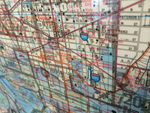Egypt's northern border is a 1,000km (600-mile) stretch of Mediterranean coastline, bracketed between the contentious border between the Sinai and the Gaza strip at the eastern end, and the border with Libya to the west.
This has historically been Egypt's interface with the Western world. The country's own rulers ignored the sea on the whole, seeming to prefer the calmer, and more easily defended, river valley and its wide, fecund delta. The coast was the scene of a number of dramatic invasions, however, and Alexandria, often called "Egypt's second city," still bears the name of the 25-year-old Macedonian who led the most famous and lasting of the early incursions -- Alexander the Great. The Ptolemaic dynasty that he left behind ran the country until the Romans took it from them in the 1st century A.D., and it wasn't until the Arab conquest of the 7th century that Egypt's center of political gravity returned again to the vicinity of Cairo.
Fourteen centuries later, it was the French who were invading, passing through Alexandria's decrepit defenses on the way to Cairo, where Napoleon's infantry slaughtered the Mamluke cavalry and effectively put a permanent end to Egypt's independence. Though the French were expelled by the British within a couple of years, at least one aspect of their legacy remains vital to the Egyptian economy.
Napoleon brought with him a team of scientists who busied themselves with everything Egyptian -- observing and recording everything that they could get at in the short time that they had the run of the country. In a coastal town 30km (18 miles) east of Alexandria named Rashid, the occupiers were rebuilding a fort when they found a large black stone carved with a decree from a 2nd century B.C. ruler, Ptolemy V. Its contents are unexciting -- taxes and temples -- but it was written in three different languages (demotic, hieroglyphs, and Greek), and this allowed scholars to decipher previously unreadable inscriptions on the monumental temples and tombs that were being unearthed in Upper Egypt. Today, Europeans and North Americans continue to flood into Egypt to see these monuments and read the inscriptions that would have remained mysterious if not for the rock, which became known as the Rosetta Stone.
Alexandria, which is almost exactly in the center of the coast, is an exciting city with a rich heritage of Roman ruins, including some of the most spectacular mosaics in the world, and European influences to explore. Damietta (Damiyut) and Rosetta (Rashid) are both worthwhile day trips, and along the coast in the direction of Libya there are the remains of a Ptolemaic temple close to the highway and Alamein, where the dramatic World War II confrontation between the dug-in Allied forces and attacking German tanks took place in 1942. The last town of any significance before Libya, Marsa Matruh has some unique diving opportunities and a lovely beach.
On the north coast, as with much of Egypt, you have to develop the trick of seeing through a thick layer of urban sprawl that has taken place in the last 30 or 40 years, as well as past the decay that has accompanied it. Many miles of once pristine beach both east and west of Alexandria have been obscured by swathes of cheap concrete "holiday village" development, and the city itself has swelled from a population of 1 million in the 1960s to almost 4 times that today, with some of the growth going into new, unplanned neighborhoods and the rest being absorbed into the neglected housing of Alexandria's old quarters. Against this backdrop, the historic treasures of the city and the surrounding towns shine, but you have to know where and how to look to pick them out.








